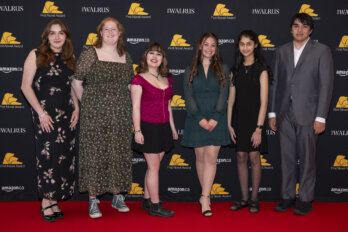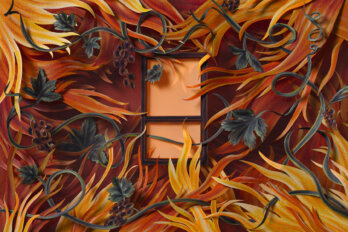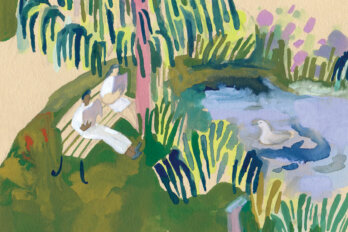
It takes a full month to reach Vostok Station by tractor train, beginning on the nightmare coast of Antarctica and ending at shacks that stick out of the snow like dirty teeth near the South Pole. In July of 2006, I travelled there to study Europa, Jupiter’s sixth moon. The ice surface of that moon covers a vast subglacial ocean, and my joint Ph.D. in aeronautical robotics and marine biology was based on the monstrous and idiotic dream that I would someday, somehow peek into it. Vostok was as close as I could get without leaving the planet: four frozen kilometres below the station, a freshwater lake nearly the size of Lake Ontario, sealed by the ice age, survives, pure and pristine, one of the earth’s final mysteries.
Like me, Sana Ostrovsky was in Antarctica for reasons other than the lake itself. The Russians called her “the nutcracker.” She had a cold face, grey eyes, close-cropped hair; I think she would have preferred baldness, to become like the robots she was endlessly perfecting. Even in Antarctica, Sana fled from others, and we never spoke outside of work—hard to do in those cramped quarters. My huge respect for her was entirely results based. Her cryobot, Cyril, had burrowed down the four kilometres of ice without carrying a single microbe into the nether waters. Her hydrobot, Hilite, could fit inside a Coke can, recharge itself without light, perform forty-seven distinct tests, and record video, all while propelling itself through the near-frozen lake water in search of new life.
By the end, everyone on crew thought we were having an affair. I can only say that we shared something infinitely deeper than our bodies or hearts.
The incomprehensible occurred two months into our explorations of the lake. The work was tedious and anxious by then. The first disappointments had passed: no ghostly centipedes, no strange-eared octopi, no clever adaptations to the lightlessness and the cold—just barren death. The biologists and microbiologists did nothing but play chess and wait for the tractor, which wasn’t coming for another four months. Sana and I pressed on, since any discovery would affect many different fields. I worked in the morning. She worked in the evening. Hilite recharged in between. A fault line ran along the edge of the lake, and we hoped to find hot springs where some strange form of life may have survived. It was one of the colder days, nearly minus sixty, when I found a note on the control panel screen: “Please recheck. All directions. From point xxxxxx.”
It could only mean she had discovered something, but I couldn’t understand why she hadn’t rushed to the whole base with the revelation. Hilite’s cameras were working well, so it couldn’t be that she needed my confirmation. I adjusted the gps on the panel to point xxxxxx. Hilite glided there without further guidance.
The spot was about twenty metres from the edge of the embankment. I rotated Hilite to the cliff face. His beams struck it straight on.
At first, I thought it was a fossil. Then I realized its shape was much too regular. It looked like a mouth or a scar about ten metres long on the jagged stone wall. It had clearly been made. As I drew closer, I noticed that the middle of this mouth was cut into regular panels. These panels were carved. They were finely, minutely carved bas-relief scenes.
The panels were nine. They told the story of a kind of god, or perhaps many gods. The first showed the birth on a road of a humanlike creature, the next the trials and tribulations of his boyhood, including his father’s brutal abuse. In the third panel, he metamorphosed miraculously into multiple forms: a military cadet, a rebellious teenager, a virgin, a pimp, an athlete, a strange mythical forest dweller, a fighter pilot. The fourth panel revealed his relationship with a curvaceous woman who gave him a book of wisdom and a machine for checking demons; the fifth his transformation into an angry veteran, a race car driver, a prizefighting immigrant, a navy lawyer, another lawyer, a vampire, a spy, an agent, a healer. His relationship with a thin woman, their prosperity, and the adoption of two children made up the sixth panel; and the seventh revealed yet further transformations, into a cynical guru, a publisher, a futuristic policeman, a samurai, a hit man, and finally a survivor being chased by creatures with tentacled heads. Panels eight and nine portrayed another relationship, with a much younger woman, and the birth of their daughter.
I found Sana sitting on the edge of her bunk eating butter mixed with sugar out of an egg cup, a traditional Vostok remedy for the bone cold. Above her bed, the boys had posted a banner that read Mens Sana in Corpora Sana, which she hadn’t bothered to tear down. I recognized my own emotion in her face when she looked up: terror rising with hope draining.
“What did you see?” she asked.
“You already know.”
“No. I know what I have seen. I do not know what you saw.”
“I saw something made. Something carved.”
“What was it?”
“I think it was the life of a Hollywood actor.”
“Which Hollywood actor?”
“Tom Cruise.”
Sana scooped the last scrap of sugary butter from her egg cup of comfort and licked it off the baby spoon. She spoke in whispers.
“That water has been untouched for millions of years. Do you understand? It has been sealed under four kilometres of ice. The human species is only 15 million years old.”
“Do you know what the final panels mean? I didn’t understand them.”
“Suri.”
“What?”
“Tom Cruise’s child with Katie Holmes.”
“I didn’t know Tom Cruise had a child.”
Sana had trouble believing that I hadn’t heard about the birth of Suri. It took some time to convince her.
I stripped the logs. Sana erased the tapes. But it’s harder to undo a number in your mind—xxxxxx. The rest of the crew thought we were having an affair, the way we wouldn’t look at one another, speak to each other. Four months later, our research at Vostok ended, with disappointment for everyone. I took my holidays in Australia and watched all of Tom Cruise’s movies in chronological order. You can watch them a million times and there’s not a glimmer of anything there. Top Gun is my favourite. I understand from the magazines that he’s working on a film about a Nazi assassin now.
A year after leaving Antarctica, Sana committed suicide, in her typically precise way, by overdosing on fentanyl. Further mercies followed: nasa fired me a month and a half ago. It has abandoned all plans for Europa.




